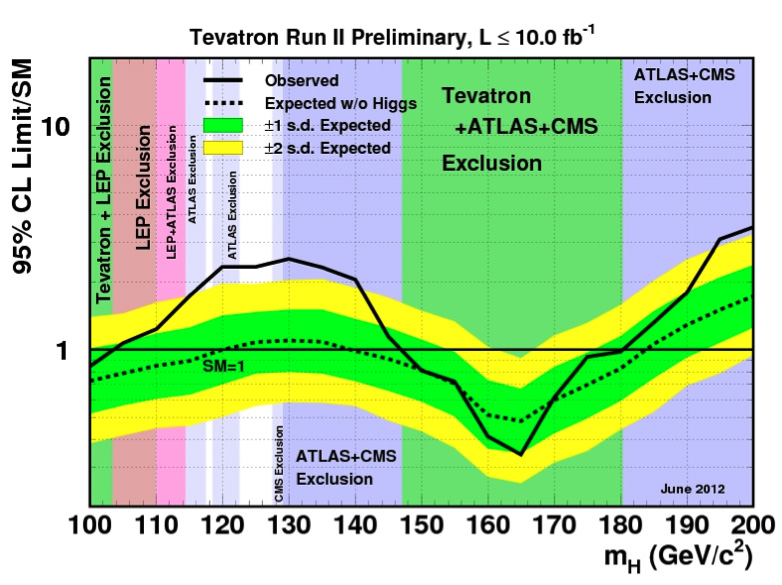The Tevatron and the Higgs Boson

If the entire Tevatron Run II program was repeated 100 times and the Higgs boson did not exist, then the observed limit (black solid line) would fall within the green band 68 times and within the green or the yellow band 95 times. The observed curve being well outside the bands between 115 and 135 GeV/c2 is thus an unlikely occurrence and an indication of a Higgs boson existence in that mass range.
The long hunt for the Higgs boson may have come to an end. The recent Tevatron results presented at the July 2 seminar at Fermilab and using the full Tevatron data set provided the strongest indication of the Higgs boson's existence at that time, and are consistent and complementary with the July 4 reports from the Large Hadron Collider experiments.
The Standard Model, the extraordinarily successful theory that describes how particles and forces interact, predicts the existence of a Higgs boson. This fundamental particle's unique characteristics render its discovery crucial for our understanding of nature, including why elementary particles have mass.
The Standard Model does not predict the mass of the Higgs boson, but it does dictate its behavior for a given mass. The Higgs boson favors decaying into a pair of b quarks below a mass of 135 GeV/c2 and into a pair of W bosons above that mass. CDF and DZero scientists exploited all decay modes in their searches to ensure that no Higgs boson event was missed in their analyses.
Since the end of the Tevatron run in September 2011, CDF and DZero scientists have been analyzing the full Tevatron data set, accumulated over past 10 years. They recently completed their analyses. Both collaborations developed substantially improved signal and background separation methods to optimize their search for the Higgs boson, with hundreds scientists from 26 countries actively engaged. After careful analysis and multiple verifications, CDF and DZero scientists found a substantial excess of events in the data beyond the background expectation in the mass region between 115 GeV/c2 and 135 GeV/c2, consistent with the predicted signal from a Higgs boson. From the study of the most probable decay channel of the Higgs boson to a pair of b quarks, currently only easily accessible at the Tevatron, the excess stands at the 2.9 sigma level, leaving only a 1 in 550 chance for the background to mimic a Higgs signal in this mass range.
Together the recent Tevatron and LHC results indicate that the particle seen at the Tevatron and LHC looks, smells and tastes like the long-hunted Higgs boson. It is a triumph of the theory that predicts the inner workings of nature and of the ingenious experiments that confirm theoretical predictions!


